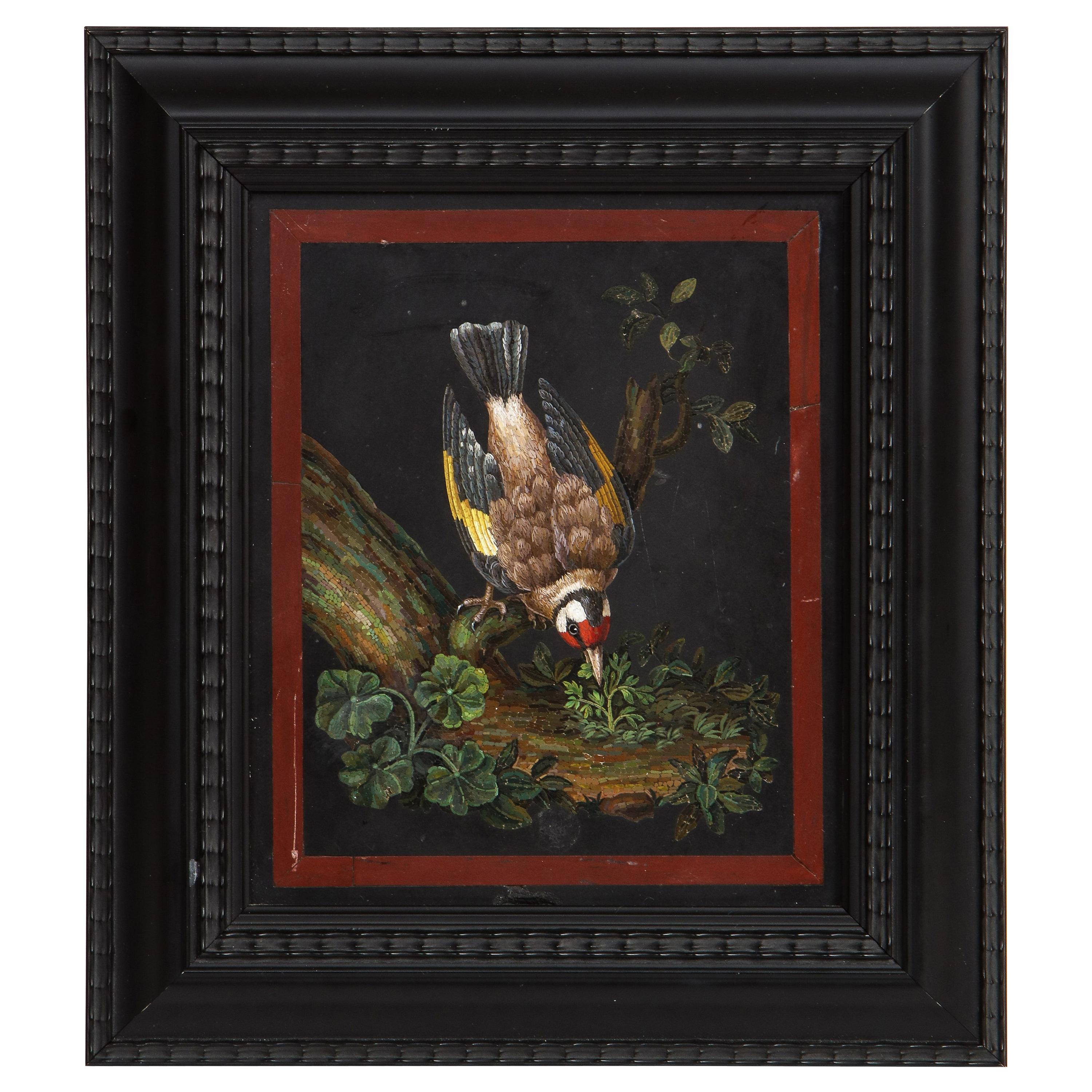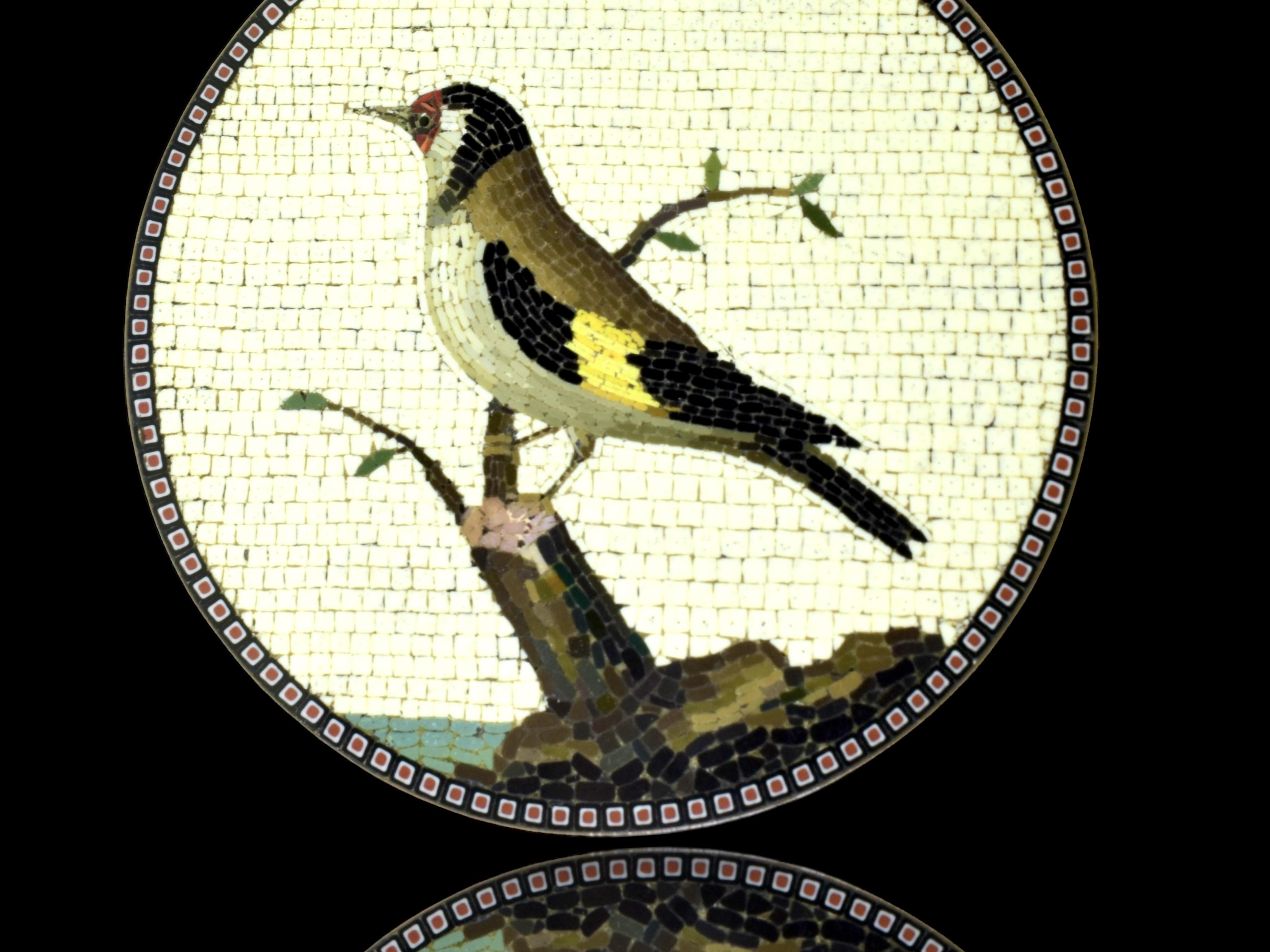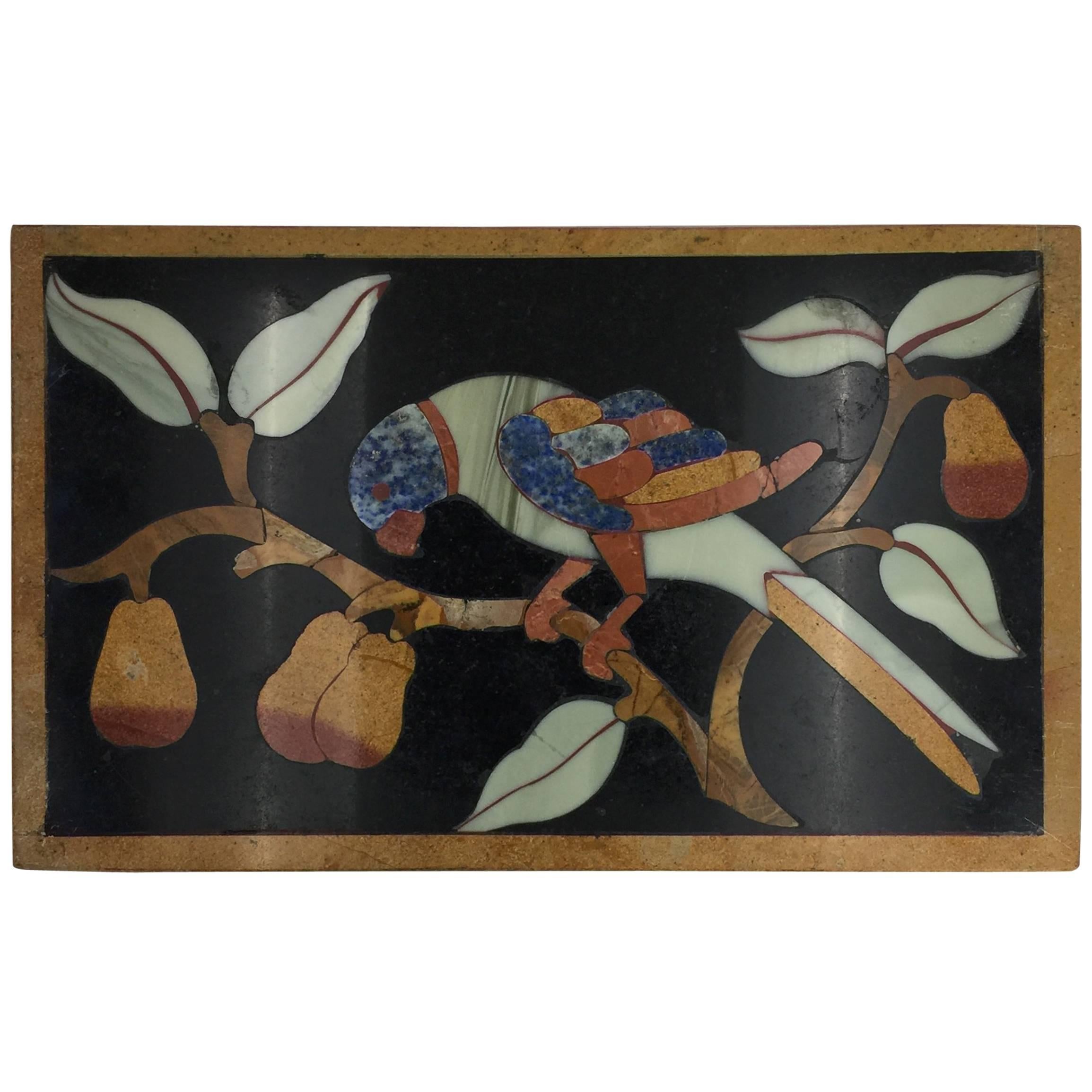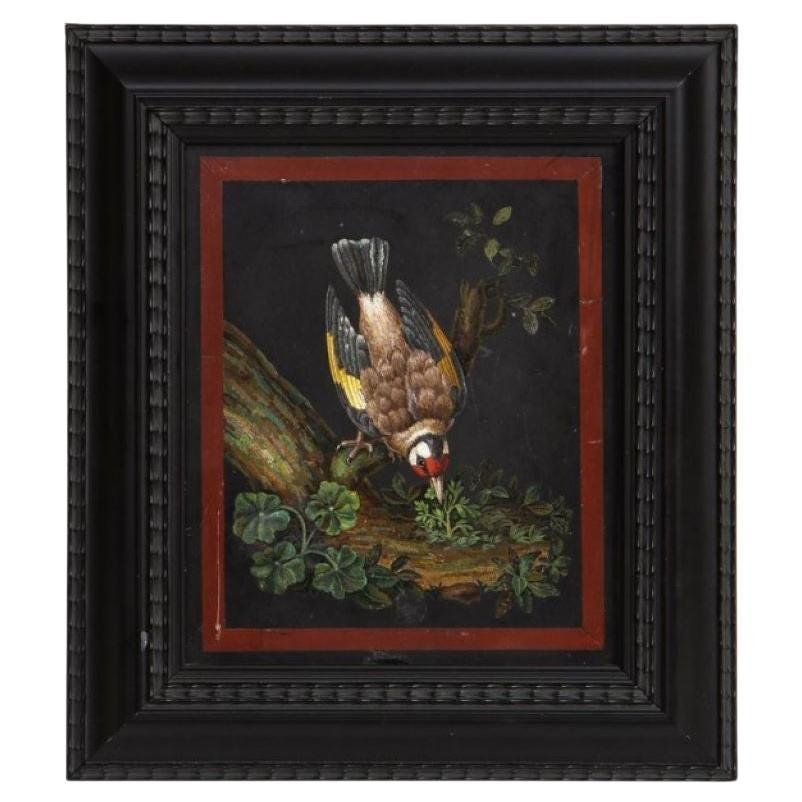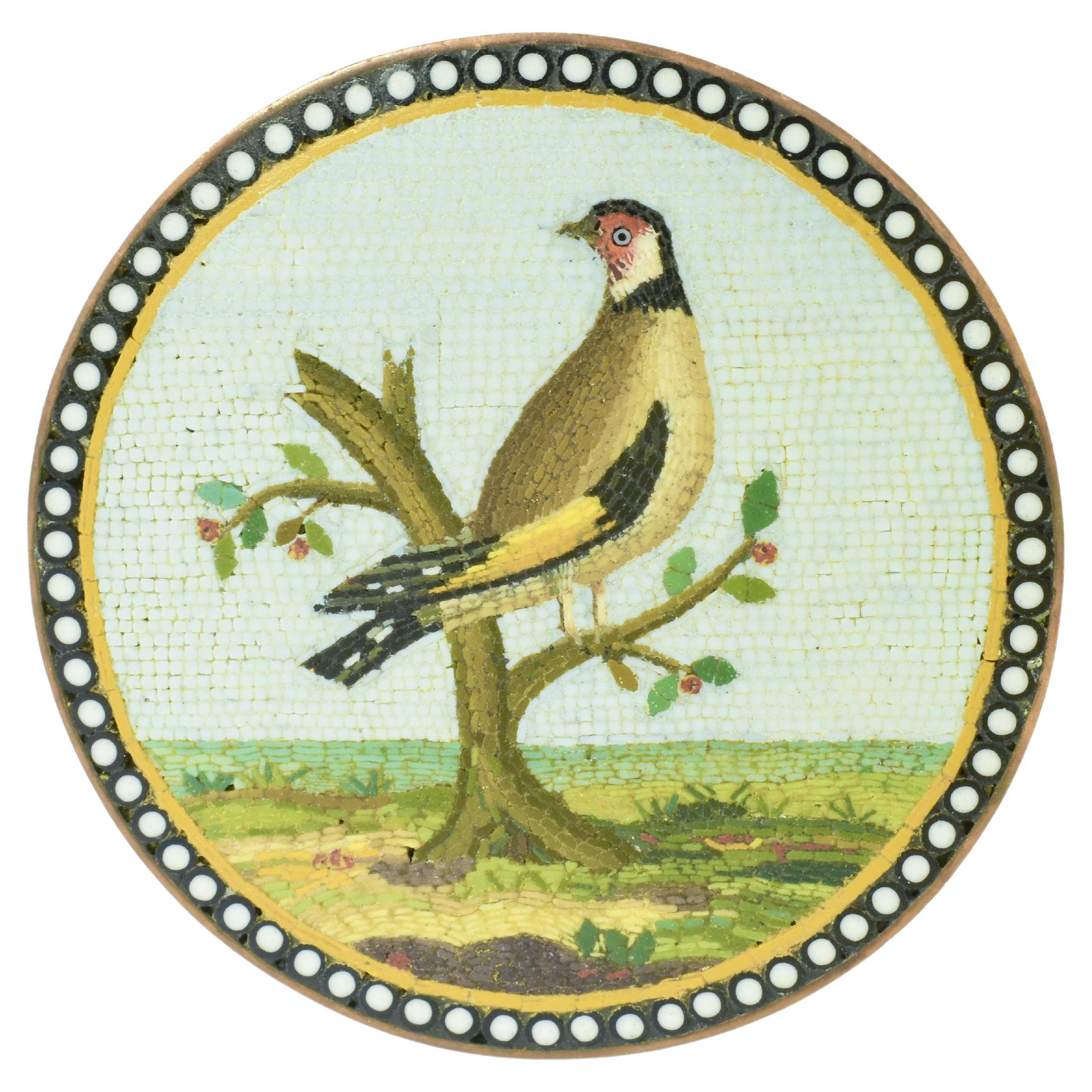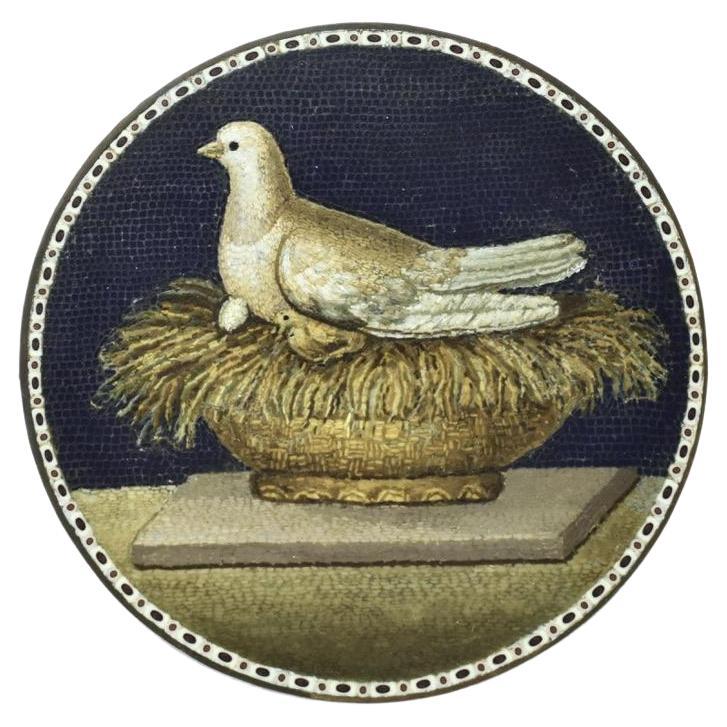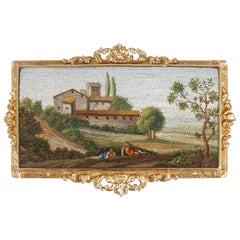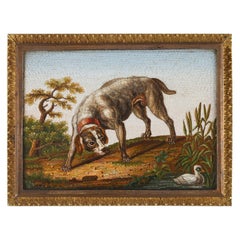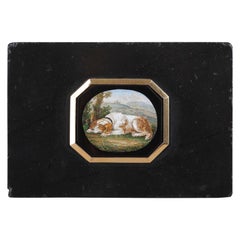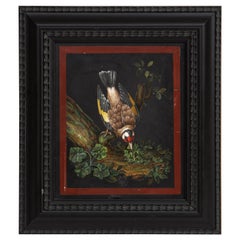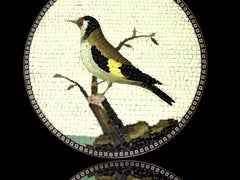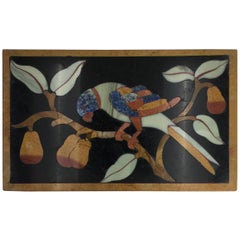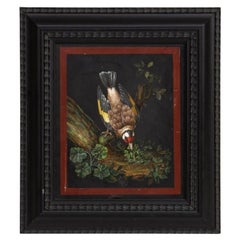Items Similar to Late 18th Century Micromosaic with Parrot on a branch. From a Model by G.Raffael
Want more images or videos?
Request additional images or videos from the seller
1 of 11
Late 18th Century Micromosaic with Parrot on a branch. From a Model by G.Raffael
$45,759.08
£33,856
€38,000
CA$63,270.07
A$69,462.65
CHF 36,238.81
MX$840,594.76
NOK 454,197.26
SEK 427,973.24
DKK 289,333.06
About the Item
Large micro-mosaic plate representing a parrot on a branch. From a model by Giacomo Raffaelli. The quality and shape of the shards of this micromosaic can date it from the late 18th century. From the end of the 18th century and throughout the 19th century, the art of micromosaics developed. These objects adorned with micromosaics will quickly become a highly sought-after memory by wealthy travelers who perform their "Grand Tour".
Roman workshop around 1790.
H: 5.7in. (14.5 cm) / L: 4.3in. (11 cm)
Collection of P-Y Le Diberder
- Similar to:Giacomo Raffaelli (Artist)
- Dimensions:Height: 5.71 in (14.5 cm)Width: 0.16 in (4 mm)Depth: 4.34 in (11 cm)
- Style:Classical Roman (In the Style Of)
- Materials and Techniques:
- Place of Origin:
- Period:1790-1799
- Date of Manufacture:1790
- Condition:Wear consistent with age and use.
- Seller Location:Paris, FR
- Reference Number:Seller: 50811stDibs: LU2065322450132
About the Seller
4.9
Vetted Professional Seller
Every seller passes strict standards for authenticity and reliability
Established in 2001
1stDibs seller since 2016
324 sales on 1stDibs
Typical response time: 2 hours
- ShippingRetrieving quote...Shipping from: Montesson, France
- Return Policy
Authenticity Guarantee
In the unlikely event there’s an issue with an item’s authenticity, contact us within 1 year for a full refund. DetailsMoney-Back Guarantee
If your item is not as described, is damaged in transit, or does not arrive, contact us within 7 days for a full refund. Details24-Hour Cancellation
You have a 24-hour grace period in which to reconsider your purchase, with no questions asked.Vetted Professional Sellers
Our world-class sellers must adhere to strict standards for service and quality, maintaining the integrity of our listings.Price-Match Guarantee
If you find that a seller listed the same item for a lower price elsewhere, we’ll match it.Trusted Global Delivery
Our best-in-class carrier network provides specialized shipping options worldwide, including custom delivery.More From This Seller
View AllRare 18th century Micromosaic Plate
Located in Paris, FR
Rare micromosaic plaque depicting an idyllic Roman landscape. The main subject of this micromosaic is the representation of buildings surrounded by cypresses and trees. Two figures i...
Category
Antique Late 18th Century French Greco Roman Models and Miniatures
Materials
Cut Glass
Early 19th Century Micromosaic Dog Chasing a Duck, After Gioacchino Barberi
Located in Paris, FR
Large micro-mosaic plate depicting a dog with a red collar chasing a duck beside the Tiber river. After Gioachhino Barberi. The Barberi family was a very ...
Category
Antique 1820s Italian Models and Miniatures
Materials
Cut Glass
Micromosaic of Shepherd, Early 19th Century
Located in Paris, FR
Rectangular micromosaic plate featuring a shepherd, seated and resting with his dog at his feet. The shepherd is wearing a woolen cloak over his colorful clothes. He is holding a hat in his left hand and his staff in his right. A wicker basket at his feet is filled with a bouquet of flowers and a bunch of grapes.
This pastoral theme is characteristic of the micromosaic production of Gioacchino...
Category
Antique 1820s French Restauration Models and Miniatures
Materials
Stone
Micromosaic and gold paperweight. After G.Barberi. Early 19th century.
By Gustav Barberini
Located in Paris, FR
A rectangular marble paperweight with octogonal inlaid micromosaic plate. The plaque depicting a spaniel in a landscape, the trunk os a tree in this left.
Depictions of dogs in micro...
Category
Antique 1830s Italian Restauration Paperweights
Materials
Marble
19th Century Restauration Snuff Box with Micromosaic
Located in Paris, FR
Small rectangular Restauration snuff box crafted in gold. The hinged lid is decorated with an oval micromosaic representing St. Peter's Square in Rome. Micromosaic is set in a gold s...
Category
Antique Early 19th Century French Charles X Tobacco Accessories
Materials
Gold
Viennese Enamel and Gilt Brass Table Clock, Mid-19th Century
Located in Paris, FR
Small table clock in gilt brass richly decorated with openwork scrollwork, acanthus leaves, flowers, and masks in multicolored enamel. The main faces...
Category
Antique 1850s Austrian Renaissance Revival Table Clocks and Desk Clocks
Materials
Enamel, Brass
You May Also Like
Very Rare 18th Century Micromosaic Depicting a Goldfinch Bird
Located in New York, NY
Very rare 18th century micromosaic depicting a goldfinch bird.
Measurements:
Without frame approximately 5.5 in x 6.5 inches
With frame approximately 8.44 x 9.63 inches.
Category
Antique 18th Century Italian Decorative Art
Materials
Stone
Giacomo Raffaelli signed & dated 1784, Rare Micromosaic Plaque of the Goldfinch
Located in Aspen, CO
Very rare 18th century micromosaic plaque of the Goldfinch. This circular plaque is 3 inches in diameter, the micromosaic is set in copper. On the verso, the piece is signed in cursi...
Category
Antique 1780s Italian George III Brooches
$19,160 Sale Price
20% Off
Free Shipping
Italian Pietre Dure Panel of Parrot on Branch, Late 17th Century
Located in Spencertown, NY
The Pietre Dure panel inset with lapis lazuli, marmo giallo, in a rectangular shape, probably a panel from a cabinet.
Category
Antique Late 17th Century Italian Baroque Decorative Art
Materials
Marble
Very Rare 18th Century Micro Mosaic Depicting a Goldfinch Bird
Located in New York, NY
Very rare 18th century Micro Mosaic Depicting a Goldfinch Bird.
Measurements:
Without frame approximately 5.5 in x 6.5 inches
With frame approximately 8.44 x 9.63 inches.
Category
Antique 18th Century Italian Frames
18th Century Micromosaic of a Goldfinch, c. 1790, attributed to G. Raffaelli
Located in Aspen, CO
18th Century micromosaic plaque of a Goldfinch, Rome, c. 1785, attributed to Giacomo Raffaelli (1753-1836). A micromosaic plaque of a goldfinch, looking left, perched on a red flowering tree branch, two inches in diameter. The ground line is parallel and low. The foreground is of different colors of grass and fallen berries and leaves. The background is a light blue with parallel lines of square tesserae. The goldfinch has both square and oblong tesserae as does the foreground. The border of a decorative pattern in white in black circles and further with a rim of yellow oblong tesserae create a colorful frame for this well executed micromosaic which is backed with copper.
There is a pinstem and "c" clasp (this type of clasp is seen both in the 18th and 19th centuries), both are not gold. This assembly could have been put on at the time of purchase or slightly later so the plaque could be worn as a brooch.
We have dated this piece as being at the end of the 18th century and attributed to Giacomo Raffaelli. This micromosaic has all of the established 18th century characteristics of micromosaics executed by Giacomo Raffaelli: 1. Each tesserae possesses one color. 2. The tesserae are either oblong or square. 3. The background is parallel horizontal rows of square tesserae, and 4. The addition of an identical border or millefiori around the edge. See page 32 of "The Gilbert Collection Micromosaics by Jeanette H. Gabriel. Philip Wilson Publishers.
Giacomo Raffaelli (1753-1836) is one the most important artists of micromosaics, his signed pieces are almost nowhere to be found - unless in museums and important collections of the world. We know of nine that exist in the world. Two in the Hermitage, two in the renowned Gilbert Collection, one in the British Museum, three held by different companies in the trade, and one held by Pierre/Famille ( for sale on this platform). Raffaelli was considered the finest mosaicist in Rome. Indeed, when Napoleon I wanted to sponsor a mosaic version of The Last Supper, in roughly 1810, he chose Raffaelli, this too added much to his fame.
A very similar plaque, also attributed to Raffaelli, can be seen in the above referenced book on page 56. This plaque is part of The Gilbert Collection. The permanent collection is on view at the Victoria & Albert Museum in London.
Raffaelli is known for his very realistic depictions of birds - especially the Goldfinch. While his naturalism is among the finest of mosaicists at this time, Raffaelli chose to display his extraordinary talent featuring the goldfinch in many of his works.
Raffaelli was probably aware of the significance of the goldfinch to the Catholic Church. Afterall, it is one of the most poignant stories in the Passion of Christ. On the road to Golgotha, Christ was forced to carry the cross upon which he would be crucified. He was also made to wear a brutal crown of thorns. It was said that a simple Goldfinch, having alighted on the Savior's shoulder, flew to his head and plucked a thorn that had been making Christ bleed; whereupon this blood was transferred to the finch, which to this day, still wears it. This is but one example as to how mosaics permitted the Church to teach important lessons or parables. Why was this not done by traditional art forms such as paintings? Why was this done instead by mosaics?
From its initial conception at approximately 319 AD, the Church sought to locate St. Peter's Basilica at the site of the apostle's martyrdom. On its face such a decision would seem rational, if not appropriate.
St. Peter however was executed in a marshy area on a side of the Tiber in the already quite humid city of Rome. Housed in the early St. Peters with its exposure for so many centuries of very high humidity most of the Basilica's artwork was beyond the help of the rudimentary preservation and restoration of the period. By about 1750 to which the "new" St. Peters dates it had therefore lost many oil and watercolor paintings as well as wood, bone, and tortoise sculptures, frames and other artifacts.
What could the Church do? Enter the "new" age of Roman micromosaics in which tiny pieces of colored stone or glass when set with grout would prove to be impervious to the debilitating effects of humidity.
By the early 1700's the Church would begin the process of establishing a school of instruction in mosaics. It would sponsor research and experimentation in developing especially glass tesserae and would encourage students to select damaged oils, paintings or watercolors as appropriate subjects for duplicative efforts in micromosaics.
Gifted instructors and successful students both frequently had their work promulgated by the Church. And it was from this pool of recently praised practitioners that fame, and special commissions paralleled each other.
By about 1780 one mosaicist in particular separated himself from most all the others. Giacomo Raffaelli became one of the most feted mosaicists in all of Rome. Indeed when Napoleon I wanted to sponsor a mosaic version of the Last Supper in roughly 1810 he chose Raffaelli. This selection itself added to the already high reputation of Raffaelli.
This micromosaic is in very good condition and probably executed by one of the greatest of mosaicists of all time, and done on a work of art symbolically significant to the early Catholic Church.
We have one of the largest collections of micromosaics offered for sale. If our reader is searching for a particular motif, we would be happy to list it here for your consideration. From very large wall hangings...
Category
Antique 1790s Italian Georgian Brooches
18th Century Micromosaic, Rome, c. 1795, Attributed to G. Raffaelli
Located in Aspen, CO
18th century micromosaic of a turtle dove on her nest with a chick, attributed to Giacomo Raffaelli.
To see a similar plaque, signed and dated Giacomo Raffaelli, 1791; see: Aste Bolaffi Auction House, lot 324, May 31, 2023, Torino Italy.
Birds were a popular motif in micromosaics in the last quarter of the 18th century and into the early 19th century. This mosaic is well executed with fine detail as seen in the shading. Little effort had been made in the dark background to follow the contour of the dove's silhouette, instead keeping the tessera in horizontal rows with square tesserae. The decorative border or millefiori of three colors around the edge create a colorful frame to this delightful scene.
All of these characteristics date this plaque as being late 18th century and most likely executed by Giacomo Raffaelli. For more detailed information, see page 32 of "The Gilbert Collection Micromosaics by Jeanette H. Gabriel. Philip Wilson Publishers. The reader will see the characteristics unique to Raffaelli. Jeannette Gabriel is considered a foremost expert in the work of Raffaelli, and was a statically important participant in the management, development and analysis of the Gilbert Collection. Her observations relative to the work of Raffaelli are therefore quite credible by art historians
This micromosaic is 2 5/8th inches in diameter, and backed in copper which is typical of plaques made at this time. This plaque was probably set onto a box of some sort as it has a glue like substance on the verso, which can be removed. We have chosen to keep this as it came to us, and in an effort to be careful, we have made no effort to remove it.
We have one of the largest collections of micromosaics offered for sale. If our reader is searching for a particular motif, we would be happy to list it here for your consideration. From very large wall hangings...
Category
Antique 1790s Italian Georgian Desk Accessories
$11,120 Sale Price
20% Off
Free Shipping
More Ways To Browse
Furniture From 1790
Mosaic Plate
Roman Micromosaic
Traveling Salesman
Antique Miniature Houses
Antique Bronze Miniature
Tower Model
Used Model Planes
Apprentice Piece
Antique Steam Engine
Miniature Boat
Vintage Bar Car
Builders Model
Antique Shoes Victorian
Used Davits
Antique Victorian Shoes
Miniature Salesman Sample
Steam Models
